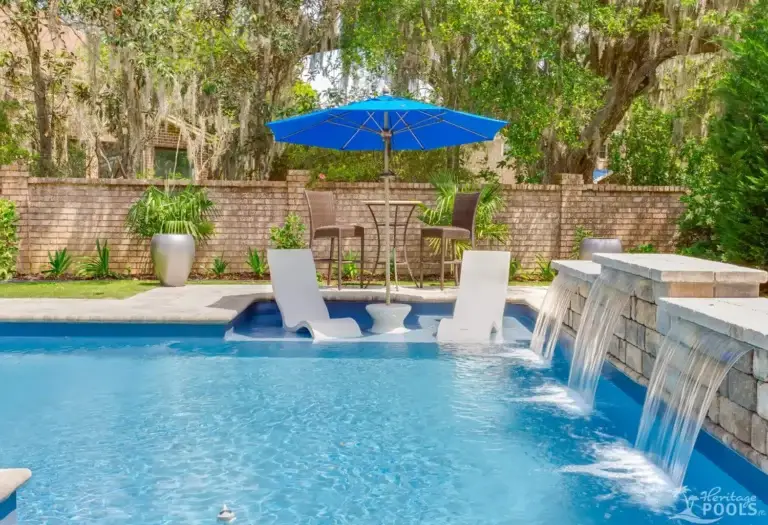As a seasoned pool company, we’ve seen it all – from murky green water to clogged filters. And one of the most common questions we hear from pool owners is, “how to vacuum a pool?” Especially at the completion of new pool projects here in Charleston, SC.
Keeping your pool sparkling clean is essential for a safe and enjoyable swim.
One of the most effective ways to maintain a clean pool is by using a pool vacuum, which can help remove dirt, debris, and other unwanted particles from your pool’s surface and bottom.
Using a pole-mounted manual vacuum can be a daunting process for the first few times and that’s why we created this guide to using a manual vacuum.
Table of Contents
What is a Pole-Mounted Pool Vacuum?
A pole-mounted pool vacuum is a type of manual pool vacuum that is designed to be attached to a telescoping pole. This type of vacuum is ideal for cleaning the bottom of your pool and hard-to-reach areas without having to get into the water.
The pole-mounted pool vacuum typically comes with a hose that connects to your pool’s filtration system to create suction and remove debris. The other end of the hose is attached to the vacuum head, which is the part that actually collects the debris. The vacuum head is designed with bristles or brushes that help loosen dirt and debris from the pool’s surface and walls.
To use a pole-mounted pool vacuum, you simply attach the vacuum head to the end of the telescoping pole, connect the hose to the vacuum head and your pool’s filtration system, and lower the vacuum head into the water. Then, you move the vacuum head around the pool to collect debris, using the pole to maneuver it.
Pole-mounted pool vacuums are popular because they allow you to clean your pool without having to get into the water or use a lot of manual effort. They are ideal for cleaning large or deep pools, as well as hard-to-reach areas such as corners and steps. They can also be more effective than other types of manual pool vacuums at removing debris from the bottom of your pool.
Overall, a pole-mounted pool vacuum is a convenient and effective tool for keeping your pool clean and clear of debris. It’s important to choose the right vacuum head and pole length for your specific pool, and to follow the manufacturer’s instructions for proper use and maintenance.
Manual Pool Vacuum Essentials
If you’re planning to use a pole-mounted pool vacuum to clean your pool, there are a few essential parts that you’ll need to assemble your vacuum system. Here’s a list of the essential parts you’ll need:
- Telescoping pole: This is the main part of your vacuum system and allows you to reach the bottom of your pool without getting in the water. The pole should be adjustable so that you can adjust its length as needed.
- Vacuum head: This is the part of the vacuum that actually collects the debris from your pool’s surface and walls. The vacuum head should have bristles or brushes to help loosen dirt and debris.
- Hose: The hose connects the vacuum head to your pool’s filtration system to create suction and remove debris. The hose should be long enough to reach all areas of your pool and should be made of durable materials.
- Skimmer plate: If your pool has a skimmer, you’ll need a skimmer plate to connect the hose to the skimmer. The skimmer plate should be compatible with your pool’s skimmer and should create a tight seal to prevent air leaks.
- Vac hose adapter: If your pool does not have a skimmer, you’ll need a vac hose adapter to connect the hose to your pool’s suction line. The vac hose adapter should be compatible with your pool’s suction line and should create a tight seal to prevent air leaks.
- Leaf trap (optional): If your pool has a lot of large debris such as leaves, you may want to consider using a leaf trap. A leaf trap connects between the vacuum hose and the skimmer or suction line, and collects larger debris before it enters the filtration system.
Preparing Your Pool for Vacuuming
Before using a pole-mounted pool vacuum to clean your pool, it’s important to properly prepare your pool to ensure optimal cleaning results. Here’s a step-by-step guide on how to prepare your pool prior to using a pool-mounted pool vacuum:
- Clean the pool’s surface: Use a skimmer net to remove any large debris from the pool’s surface, such as leaves and twigs. This will prevent the debris from clogging your vacuum system.
- Brush the pool’s walls and floor: Use a pool brush to loosen any dirt and debris on the pool’s walls and floor. This will make it easier for your pool-mounted pool vacuum to collect the debris.
- Check the pool’s water level: The water level in your pool should be at least halfway up the skimmer opening. If the water level is too low, add water to the pool to prevent damage to your pool’s equipment.
- Check the pool’s water chemistry: Use a pool test kit to check the pH, chlorine, and alkalinity levels in your pool’s water. Adjust the chemicals as needed to ensure they are within the recommended ranges.
- Backwash the filter: If you have a sand or DE filter, backwash it to remove any debris and ensure it’s operating at its best.
- Clean the skimmer and pump baskets: Remove any debris from the skimmer and pump baskets to ensure water flow is not restricted.
- Turn off automatic pool cleaners: If you have an automatic pool cleaner, turn it off before using your pool-mounted pool vacuum to avoid interference and potential damage.
How to Vacuum a Pool
Using a pole-mounted pool vacuum to clean your pool can be an effective and efficient way to remove dirt and debris from your pool’s surface and walls. Here’s a step-by-step guide on how to use a pole-mounted pool vacuum for best results:
- Assemble your vacuum system: Make sure you have all the essential parts of your vacuum system, including the telescoping pole, vacuum head, hose, skimmer plate or vac hose adapter, and leaf trap (if needed). Follow the manufacturer’s instructions to assemble your vacuum system correctly.
- Connect the hose to the vacuum head: Attach one end of the hose to the vacuum head and secure it tightly.
- Connect the hose to the skimmer or suction line: If your pool has a skimmer, connect the other end of the hose to the skimmer plate and secure it tightly. If your pool does not have a skimmer, connect the hose to the vac hose adapter and secure it tightly.
- Lower the vacuum head into the pool: With the pole extended to its full length, lower the vacuum head into the pool, ensuring it is fully submerged.
- Move the vacuum head around the pool: Use the pole to maneuver the vacuum head around the pool, focusing on areas with the most debris. Move the vacuum head slowly and steadily to ensure it collects as much debris as possible.
- Empty the leaf trap (if needed): If you are using a leaf trap, empty it periodically to prevent it from becoming clogged.
- Monitor the pool’s water level: As you vacuum, the water level in your pool may drop. Check the water level periodically and add water as needed to prevent damage to your pool’s equipment.
- Finish vacuuming: Once you have vacuumed the entire pool, turn off the pump and remove the vacuum head from the pool.
- Clean and store your vacuum system: Disconnect the hose from the skimmer or suction line and the vacuum head, and clean all parts thoroughly with water. Store the vacuum system in a dry, safe place until its next use.
Tips for Manually Vacuuming Your Pool
- Vacuum in sections: To ensure that you vacuum your pool thoroughly, it’s a good idea to divide it into sections and vacuum each section separately. This will help you to avoid missing any areas and to make sure that you clean your pool completely.
- Move slowly and steadily: When vacuuming your pool, it’s important to move the vacuum head slowly and steadily to ensure that you pick up as much debris as possible. If you move too quickly, you may miss some debris or push it out of the vacuum’s path.
- Empty the leaf trap regularly: If you’re using a leaf trap, make sure to empty it regularly to prevent it from becoming clogged. A clogged leaf trap can reduce your vacuum’s suction power and make cleaning your pool more difficult.
- Check the hose for leaks: Before vacuuming your pool, check the hose for any leaks or cracks. A leaky hose can reduce suction power and prevent your vacuum from cleaning effectively.
- Use the right vacuum head for your pool: Make sure that you choose a vacuum head that is designed for your pool type and size. Using the wrong vacuum head can reduce suction power and make cleaning your pool more difficult.
Vacuuming an Inground Pool vs an Above Ground pool
Using a pole-mounted pool vacuum on an inground pool is different from using it on an above ground pool. Here are some of the main differences to keep in mind:
- Pool shape and depth: Inground pools are typically larger and deeper than above ground pools, which means that you’ll need a longer telescoping pole to reach the bottom of the pool. You may also need a different vacuum head to accommodate the shape and size of your inground pool.
- Filtration system: Inground pools usually have a more powerful filtration system than above ground pools, which means that you may need a more powerful vacuum to keep up with the filtration system. You may also need to adjust your pool’s filtration settings to ensure optimal cleaning performance.
- Hose connections: The hose connections for inground and above ground pools may be different, so it’s important to ensure that your vacuum system is compatible with your pool type.
- Wall construction: Inground pools typically have concrete or plaster walls, which may require a different vacuum head or brush to effectively clean. Above ground pools typically have vinyl walls, which require a different type of vacuum head and brush.
- Cleaning frequency: Inground pools may require more frequent cleaning than above ground pools, especially if they are used frequently or have a lot of debris. You may need to adjust your cleaning schedule to accommodate your pool type.




